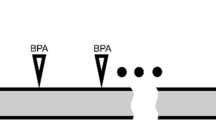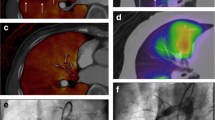Abstract
Objective
Balloon pulmonary angioplasty (BPA) is used to treat patients with inoperable chronic thromboembolic pulmonary hypertension (CTEPH); the goal is to improve pulmonary perfusion. We aimed to evaluate lung perfusion blood volume (PBV) with haemodynamic and exercise-capacity parameters to assess the efficacy of BPA in the treatment of CTEPH.
Methods
We retrospectively studied 33 patients over a 6-year period. DECT pulmonary angiography was performed before and after BPA. DECT provided iodine distribution maps; whole-lung and regional PBV images and quantification were generated using post-processing software. A mosaic pattern suggesting perfusion inhomogeneity is typical in CTEPH. Hypothetically, BPA treatment would promote homogenization that would be reflected in the calculated standard deviation.
Results
Lung perfusion images showed decreased heterogeneity after BPA. There was a significant difference before and after BPA in the whole-lung PBV and in the regional standard deviation for pulmonary arterial pressure (R = 0.37, p = 0.032 and R = 0.57, p = 0.006), pulmonary vascular resistance (R = 0.51, p = 0.023 and R = 0.60, p = 0.002), transtricuspid pressure gradient (R = 0.50, p = 0.0028 and R = 0.61, p = 0.0001), brain natriuretic peptide (R = 0.54, p = 0.0012 and R = 0.46, p = 0.0078), and 6-min walking distance (R = 0.59, p = 0.003 and R = 0.26, p = 0.14). The effects were especially pronounced after the first BPA procedure.
Conclusion
Decreased lung heterogeneity may suggest BPA efficacy in treating CTEPH. After BPA treatment, improved lung PBV and improved regional standard deviation showed a strong positive correlation with haemodynamic parameters and exercise capacity, which also suggests that BPA is effective in treating CTEPH.




Similar content being viewed by others
Abbreviations
- BPA:
-
Balloon pulmonary angioplasty
- CTEPH:
-
Chronic thromboembolic pulmonary hypertension
- PBV:
-
Perfusion blood volume
- PTE:
-
Pulmonary thromboembolism
References
Piazza G, Goldhaber SZ (2011) Chronic thromboembolic pulmonary hypertension. N Engl J Med 364(4):351–360
Jamieson SW, Kapelanski DP, Sakakibara N, Manecke GR, Thistlethwaite PA, Kerr KM et al (2003) Pulmonary endarterectomy: experience and lessons learned in 1,500 cases. Ann Thorac Surg 76(5):1457–1462
Archibald CJ, Auger WR, Fedullo PF, Channick RN, Kerr KM, Jamieson SW et al (1999) Long-term outcome after pulmonary thromboendarterectomy. Am J Respir Crit Care Med 160(2):523–528
Feinstein JA, Goldhaber SZ, Lock JE, Lock JE, Ferndandes SM, Landzberg MJ (2001) Balloon pulmonary angioplasty for treatment of chronic thromboembolic pulmonary hypertension. Circulation 103(1):10–13
Andreassen AK, Ragnarsson A, Gude E, Geiran O, Andersen R (2013) Balloon pulmonary angioplasty in patients with inoperable chronic thromboembolic pulmonary hypertension. Heart 99(19):1415–1420
Taguchi Y, Miyagawa K, Nakayama K, Kinutani H, Shinke T, Okada K et al (2014) Balloon pulmonary angioplasty: an additional treatment option to improve the prognosis of patients with chronic thromboembolic pulmonary hypertension. Eurolntervention 10(4):518–525
Ogo T (2015) Balloon pulmonary angioplasty for inoperable chronic thromboembolic pulmonary hypertension. Curr Opin Pulm Med 21(5):425–431
Lang I, Meyer BC, Ogo T, Matsubara H, Kurzyna M, Ghofrani HA et al (2017) Balloon pulmonary angioplasty in chronic thromboembolic pulmonary hypertension. Eur Respir Rev. 26(143):160119
Jin Q, Luo Q, Yang T, Zeng Q, Yu X, Yan L et al (2019) Improved hemodynamics and cardiopulmonary function in patients with inoperable chronic thromboembolic pulmonary hypertension after balloon pulmonary angioplasty. Respir Res 20(1):250
Dournes G, Verdier D, Montaudon M, Bullier E, Rivière A, Dromer C et al (2014) Dual-energy CT perfusion and angiography in chronic thromboembolic pulmonary hypertension: diagnostic accuracy and concordance with radionuclide scintigraphy. Eur Radiol 24(1):42–51
Koike H, Sueyoshi E, Sakamoto I, Uetani M, Nakata T, Maemura K (2016) Quantification of lung perfusion blood volume (lung PBV) by dual-energy CT in patients with chronic thromboembolic pulmonary hypertension (CTEPH) before and after balloon pulmonary angioplasty (BPA): preliminary results. Eur J Radiol 85(9):1607–1612
Hozo SP, Djulbegovic B, Hozo I (2005) Estimating the mean and variance from the median, range, and the size of a sample. BMC Med Res Methodol 5:13
Iwase T, Nagaya N, Ando M, Satoh T, Sakamaki F, Kyotani S et al (2001) Acute and chronic effects of surgical thromboendarterectomy on exercise capacity and ventilatory efficiency in patients with chronic thromboembolic pulmonary hypertension. Heart 86(2):188–192
Manabe H, Nakatani S, Sugawara M, Mimura J, Nakanishi N, Ogino H et al (2007) Different time course of changes in tricuspid regurgitant pressure gradient and pulmonary artery flow acceleration after pulmonary thromboendarterectomy: implications for discordant recovery of pulmonary artery pressure and compliance. Circ J 71(11):1771–1775
Rose C, Smith MD (2002) Mathematical statistics with mathematica. Springer-Verlag, New York
Ameli-Renani S, Ramsay L, Bacon JL, Rahman F, Nair A, Smith V et al (2014) Dual-energy computed tomography in the assessment of vascular and parenchymal enhancement in suspected pulmonary hypertension. J Thorac Imag 29(2):98–106
Fleiss JL, Levin B, Paik MC (1981) Statistical methods for rates and proportions, 2nd edn. Wiley, New York, pp 14–15
King MA, Bergin CJ, Yeung DW, Belezzouli EE, Olson LK, Ashburn WL et al (1994) Chronic pulmonary thromboembolism: detection of regional hypoperfusion with CT. Radiology 191(2):359–363
Ferda J, Ferdová E, Mírka H, Baxa J, Bednářová A, Flohr T et al (2011) Pulmonary imaging using dual-energy CT, a role of the assessment of iodine and air distribution. Eur J Radiol 77(2):287–293
Sakamoto A, Sakamoto I, Nagayama H, Koike H, Sueyoshi E, Uetani M (2014) Quantification of lung perfusion blood volume with dual-energy CT: assessment of the severity of acute pulmonary thromboembolism. AJR Am J Roentgenol 203(2):287–291
Author information
Authors and Affiliations
Corresponding author
Ethics declarations
Conflict of interest
The authors declare that they have no conflict of interest to declare.
Additional information
Publisher's Note
Springer Nature remains neutral with regard to jurisdictional claims in published maps and institutional affiliations.
Rights and permissions
About this article
Cite this article
Koike, H., Sueyoshi, E., Nishimura, T. et al. Effect of Balloon Pulmonary Angioplasty on Homogenization of Lung Perfusion Blood Volume by Dual-Energy Computed Tomography in Patients with Chronic Thromboembolic Pulmonary Hypertension. Lung 199, 475–483 (2021). https://doi.org/10.1007/s00408-021-00471-5
Received:
Accepted:
Published:
Issue Date:
DOI: https://doi.org/10.1007/s00408-021-00471-5




